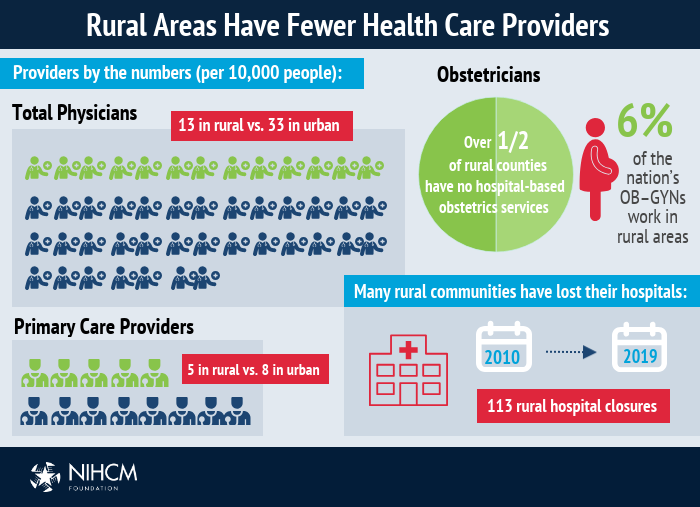NIHCM Newsletter / September 2019
Expanding the Rural Health Care Workforce

While there are 33 providers for every 10,000 people in urban areas, rural areas only have 13 providers on average to serve the same number of people. One approach to expanding the rural health care workforce is to invest in rural residency programs, as residents who serve in rural areas are more likely to continue to practice there. The U.S. Department of Health and Human Services recently awarded $20 million to 27 organizations across 21 states to create new rural residency programs. Private payers are helping too - in Washington, Premera Blue Cross is granting $5.5 million to support rural residency programs across the state. An additional $5 million will help rural providers invest in needed medical technology and infrastructure.
Signs of Progress? New Data on Substance Use & Mental Health
In August, the U.S. Substance Abuse and Mental Health Services Administration released a new report summarizing key findings from the 2018 National Survey on Drug Use and Health. One highlight: fewer people between the ages of 12 to 25 became new misusers of pain relievers than in 2015 and 2016. While this is perhaps a sign of progress emerging from the opioid crisis, a recent report from the Centers for Disease Control and Prevention found that there is room for improvement when it comes to opioid prescribing practices. CDC guidelines recommend prescribing overdose reversal drug naloxone along with high-dose opioid prescriptions, but in 2018, naloxone was only dispensed with 1 in every 69 high-dose opioid prescriptions. While experts think it may not be practical to get dispensing ratios down to 1 to 1, public health officials hope to see higher rates of naloxone prescribing.

The Opioid Crisis: An Interactive Look
Through a new series of interactive data visualizations, we depicted how the opioid crisis changed in character and in magnitude from 2000 to 2017. For the first time, we captured unduplicated counts of the number of overdose deaths involving specific combinations of prescription opioids, heroin and synthetic opioids. We also show the shifting demographics of the crisis, which increasingly affected a greater number of younger adults around the same time that use of synthetic opioids spiked.
Housing, Food Access & More: Investing in Social Determinants of Health
Where we live, where we work, and associated environmental factors are the biggest drivers of our health; not the medical care we receive. In recognition of the importance of social determinants to overall health, payers are increasingly investing in programs to address the whole health of their members and communities:
- Florida Blue is hiring social workers at 25 Florida Blue Centers to help visitors navigate issues outside the scope of their health plan.
- Blue Cross and Blue Shield of Illinois is investing $1 million in housing through Chicago's Flexible Housing Pool, which helps the homeless to find permanent housing in addition to providing wraparound services.
- In Ohio, Anthem is partnering with the National Alliance on Mental Illness Ohio and the Adam-Amanda Mental Health Rehabilitation Center to help people struggling with mental health as well as housing instability to find supportive housing and create a stable home environment.
- Blue Cross and Blue Shield of Minnesota Foundation is focusing on social determinants like healthy eating and physical activity to fight health inequity in the state by investing nearly $400,000 in 15 community partners.
More Related Articles
See More on: Rural Health | Social Determinants of Health
